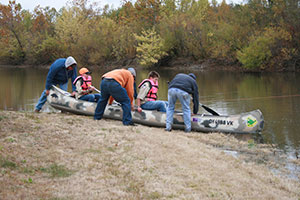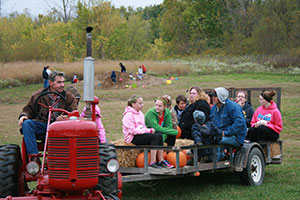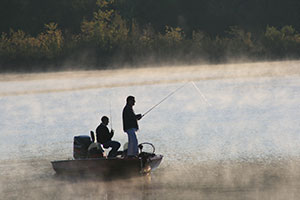Oldcastle Materials site receives special award for improving biodiversity
Reclaiming a spent sand-and-gravel mining facility is one thing. Having Wildlife Habitat Council (WHC) recognize your efforts to partner with company employees, community organizations, youth groups and environmental education leaders in the process is quite another.

As a result of The Shelly Co.’s reclamation efforts, the public enjoys canoeing and other water sports at the reclamation site. Photo courtesy of The Shelly Co.
WHC is a national organization that was established for the purpose of involving people in managing lands to provide enhanced habitat for wildlife. The WHC Corporate Lands for Learning program selected The Shelly Co.’s 96-acre former aggregate mining facility, Dresden Wildlife Habitat, as the winner of the 2013 Corporate Lands for Learning of the Year Award.
WHC selects a single wildlife management project each year from a group of applicants in order to recognize outstanding environmental education, stewardship and voluntary employee efforts.
Dresden Wildlife Habitat is adjacent to the Muskingum River in eastern Ohio. Previous mining practices there resulted in the creation of several lakes and ponds that are interspersed with riparian flood plain forest and seasonally wet meadows. Riparian zones, forests and grasslands provide habitats for a number of native Ohio species, including great blue heron, kingfishers, osprey, bald eagles, beavers, river otters and white-tailed deer.
Ty Nofziger, president of The Shelly Co., which is a subsidiary of Oldcastle Materials, says his organization partnered with several groups to increase the site’s biodiversity, improve native prairie and lakeside habitats, and to identify, inventory and monitor yearly activity there.
“Those who have and continue to work with us in developing this site include Boy Scouts of America troops, Girl Scouts of America troops, Tri-Valley Middle and High Schools, West Muskingum School District, Muskingum County Soil and Water Conservation District, and the Ohio Department of Natural Resources,” Nofziger says. “The site is now host to many community and employee activities, including an Earth Day celebration, a fall festival and a Christmas tree donation drive. An employee bass tournament is also held there.”
The starting point
Oldcastle Materials first partnered with WHC in 2004 to promote conservation and improve biodiversity on the company’s corporate lands through the establishment of wildlife habitat sites. John Powers, Oldcastle’s Central Division president, says the WHC partnership is an opportunity for his company to demonstrate environmental stewardship and corporate social responsibility.
“By formulating and implementing a balanced and operative wildlife management program on some of the company’s landholdings, we are fulfilling our commitment to sustainability,” Powers says. “Sustainability is wide-ranging and includes many environmentally friendly initiatives. These habitats are the most visual and obvious examples of that work.”
According to Powers, Oldcastle strives to be a role model to improve the reputation of the industry, providing concrete examples of the company’s commitment to sustainability initiatives.
“Currently, Oldcastle Materials has 18 certified wildlife habitat sites,” he says. “The Shelly Co. has five wildlife habitat sites throughout Ohio. In each of those communities we take pride in being good neighbors and socially responsible corporate citizens.”

An annual fall festival Oldcastle Materials hosts at the Dresden Wildlife site allows members of the surrounding community to gather and enjoy the many recreational activities the site supports. Photo courtesy of The Shelly Co.
The project
Native prairie habitat creation efforts at the Dresden Wildlife Habitat site began in April 2006. At that time, employees organized disking and removal of undesirable vegetation to prepare a six-acre portion of the site for planting native warm-season grasses and wildflowers. Among the grasses to be planted were switchgrass, ox-eye daisy, wild quinine, New England aster, wild bergamot and Indian grass.
The initial activities also included the establishment of a pollinator garden and the construction of nesting boxes, as well as a bluebird nest box trail to further enhance the prairie habitat.
“To improve lakeside habitat for wildlife species, employees and volunteers set up basking logs, brush piles and platforms in and around water resources,” Nofziger says. “Several grass and tree species were also planted to control bank erosion in wetland areas.”
In order to become eligible for WHC awards, the Dresden Wildlife Habitat site had to be certified through WHC. Restoration, creation, protection and enhancement of habitat and individual species management are among the types of projects eligible for WHC certification. Certification requirements are stringent and require full documentation of activity. Prior to certification, a WHC biologist visits the site. Re-certification is required every three years.
“In order to fulfill the recertification requirements, it is key to perform ongoing tasks throughout the year such as species inventories, project progression, photo library and maintain current projects, as well as engage with our community members and employees,” says Kevin Cooperrider, The Shelly Co.’s property and mine services manager. “Whether it’s making rock, paving roads or managing wildlife sites, our Shelly team members strive for the best results in everything we do.”
“The Dresden site first completed Wildlife at Work certification in 2007,” Nofziger adds. “The site was re-certified in 2009 and 2012. Certification for the Corporate Lands for Learning Award was first achieved in 2008. Recertification for that program was accomplished in 2010 and again in 2013.”
Cooperrider notes that by incorporating the Corporate Lands for Learning certification into their program, The Shelly Company was able to expand efforts to select groups interested in learning and exploring the outdoor land lab.
“Since the sites are managed on private land, all visits are scheduled and supervised by a wildlife team member,” Cooperrider says. “The Dresden 11-member wildlife team is comprised of local community members, teachers and employees.”
As a certified WHC Wildlife at Work and Corporate Lands for Learning site, the Dresden Wildlife Habitat site provides environmental-based education to schools, scouts, community groups and organizations of all ages. These activities raise awareness, improve leadership skills and encourage responsible behavior toward natural resources and wildlife.
The Dresden team
The Dresden wildlife team, assisted by the environmental clubs and science teachers at Tri-Valley Schools, developed a curriculum that incorporated Project Wild lessons and supports the academic goals of the schools, according to Nofziger.

A pair of fishermen take advantage of the lake at the reclaimed operation. Photo courtesy of The Shelly Co.
“Boy Scouts have utilized the site to earn their highest honor, the Eagle Scout Award, by constructing 23 projects to provide wildlife and site enhancements,” Nofziger says. “Their projects include an informational kiosk, shelter houses, weather-resistant garbage and recycling containers, trail sign markers, wetland steps and more.”
The Dresden Wildlife Habitat site was the first Oldcastle-certified WHC Corporate Lands for Learning program. In addition to bringing the company national recognition for their efforts, the site became one for hiking, canoeing, camping, boating and other nature adventures for a range of groups.
“Oldcastle Materials has standards and guidelines and provides initial funding associated with establishing each site,” Powers says. “The local company has the discretion to create and develop its site and maintain the wildlife program.”
Oldcastle’s wildlife habitat sites vary in nature and scope, from larger-scale prairie and wetland restoration to individual species management and native planting projects.
“Sites can be established on excess property, in buffer zones and on small plots or parcels adjacent to active production facilities, or even at the entrance to a facility,” Powers says.
Regulations and reclamation
Quarry reclamation is highly regulated by states. Oldcastle and its subsidiary companies work hard to return mined lands to a condition that’s potentially more environmentally healthy than they were prior to mining activities, Powers says.
“Creating wildlife habitat sites as part of our reclamation process has proven to create win-win scenarios for our local companies and Oldcastle Materials as a whole,” he says. “Our company provides employees the opportunity to become involved with wildlife habitat sites by volunteering on wildlife management teams at the local companies and corporate office.”
As part of the wildlife habitat projects, Oldcastle employees have the opportunity to participate in annual online professional development courses. Each employee serving on Oldcastle’s wildlife management teams has the opportunity to attend the WHC Annual Symposium to share knowledge with other corporations, government agencies and conservation leaders.
“Social responsibility is an integral part of Oldcastle Materials’ business strategy,” Powers says. “Oldcastle Materials is committed to providing quality products in a responsible manner while working to preserve and enhance the well-being of the environment.”
Company policy
The Oldcastle environmental policy requires Oldcastle Materials’ companies to:
- Comply, at a minimum, with all applicable environmental legislation and continuously improve environmental stewardship
- Ensure employees and contractors respect environmental responsibilities
- Proactively address the challenges and opportunities of climate change
- Optimize the use of energy and resources through efficiency gains and recycling
- Promote environmentally driven products, process innovation and new business opportunities
- Be a good neighbor in the many communities in which the companies operate
The WHC Award
The Corporate Lands for Learning of the Year Award recognizes a program each year for outstanding environmental education, stewardship and voluntary employee efforts. Candidates are generated from a pool of applications for recertification in a given year and nominated by Wildlife Habitat Council’s (WHC) Certification Review Committee. Nominated applications are submitted to a panel of independent professional judges for review and decision. Nominees and winners are chosen based on the following criteria:
- Sound curriculum – The curriculum employed by the site is designed to teach students about wildlife habitat and biodiversity protection in a way that promotes investigation, critical thinking and team building.
- Scope of projects – The curriculum uses the habitat to teach and engages the students in multi-disciplinary education, including subjects such as language, social studies, math and art.
- Level of commitment – The wildlife team should be highly committed, demonstrated by the contribution of time, effort and resources relative to the size of the site. Commitment is also reflected by the Hours of Active Learning that take place at the site.
- Outside group involvement – The wildlife team should involve the community in designing, implementing and evaluating the Corporate Lands for Learning program. This can occur through actively involving educators, non-governmental organizations, governmental agencies and youth group leaders on a regular basis.
- Length of involvement – The Review Committee examines the program based on how long it has been maintained with or before involvement of WHC, and/or how long it will take to implement and achieve the program’s stated goals.
- Credibility – The program should stand up to scrutiny by members of the conservation and education professions and provide a model for other companies.
Take note
Oldcastle Materials employees can participate in annual online professional development courses as part of the company’s wildlife habitat projects.
Loretta Sorensen is a freelance writer in Yankton, S.D. She produces material on a variety of topics, serves as a ghostwriter, and has authored her own books.









